"A Party of Nimrods": An 1896 Hunting Expedition into Yellowstone National Park
By: Noa Greenspan '23
Access the two digitized photo albums of the expedition via Princeton University Library.
On September 4th, 1896, the New York Journal announced that "the most elaborately equipped hunting party that ever was known in the United States" would depart in the coming days for Yellowstone National Park, with Dr. William Seward Webb leading the charge.
According to the Journal, the trip had been "elaborately planned" with "every arrangement ... made for the comfort of those who are to take part in it." Yet alongside his descriptions of a comfortable journey, the author of the article also suggested that the mission was one of daring and risk. "Though it is hoped the car will always be available as a base of supplies," went the article, "Dr. Webb is not at all sure ... The route planned will lead in some cases far from railroads or settlements in which [no] supplies other than the coarsest can be secured, and the guests have been warned that they must start prepared to rough it." At other times, the author wrote of the danger of encountering "desperadoes" en route and noted that the party's return date was uncertain. The account of the men's audacity and skill even veered toward the Biblical in the article's subheading, referring not to dimwits but to the god-hunter of ancient Mesopotamia: "W. Seward Webb to Be in a Party of Nimrods."[1]
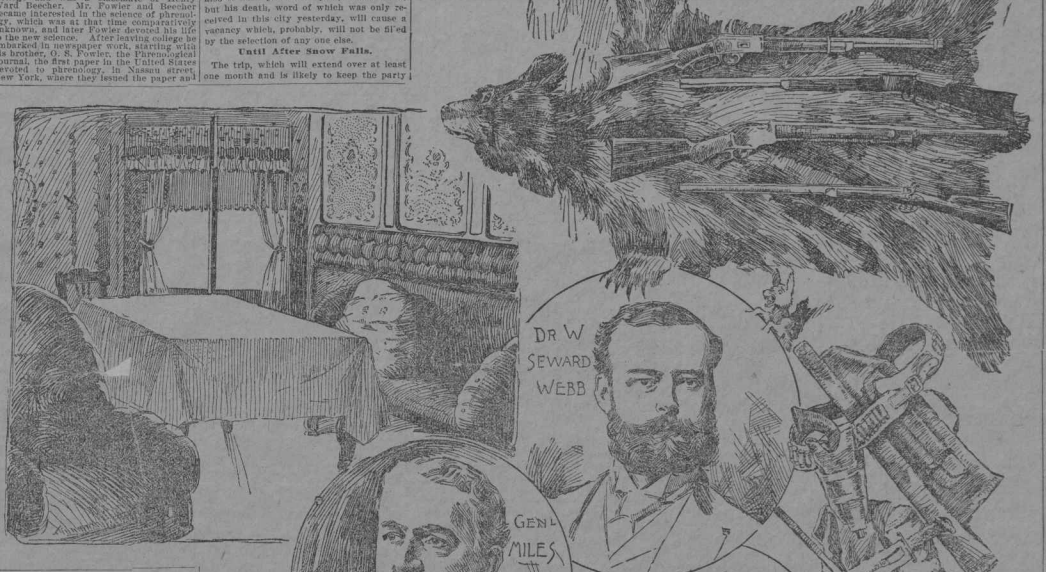
Two accounts of that expedition now reside in Firestone Library, part of Princeton's Collections of the American West. The hardcover books open with several pages of narration describing the day-to-day journey. In the back of the books are photographs, with each image taking up nearly an entire page. They were captured by Yellowstone National Park's official photographer F.J. Haynes, who accompanied the men on the trip.
Although the photographs are nearly identical across both copies, the text differs significantly. One copy was authored by the party's self-described “Historian” J.H. Purdy. While describing the group’s itinerary, Purdy certainly engaged in some editorializing. He was a self-deprecating author who lightly poked fun at himself and his friends along their journey. One running joke, for instance, involved a friend who continually lost his things, including his ammunition, his clothes, his glasses, a bet, and finally his temper.
We know that there were multiple copies of Purdy’s version printed. One copy has been sold from the rare book dealer Sotheby’s, while another is currently for sale from the William Reese Company.[2] Another copy resides in the University of Vermont’s collections.[3] Purdy’s humorous writing style and the fact that there are so few known copies suggests that the book was likely printed for the members of the trip themselves and not for wider circulation.
The other copy in Princeton’s collection appears to be unique; I was not able to find any similar versions in libraries or on the market. While Purdy’s narrative has been printed directly onto the pages, the other version’s itinerary has been printed on a typewriter and glued onto the pages. The writing style is markedly different from Purdy’s, describing the men’s travel and activities in simple, bare-bones terms. An inscription at the front of the book signed by Webb himself indicates his potential authorship. Watermarks on the pages of both books indicate that they were produced at the Crane paper company in Dalton, Massachusetts. The watermark on Purdy’s copy is stamped “1897,” while the other is stamped “1896.” The fact that the bare-bones version was produced earlier perhaps suggests that it may have served as a kind of dummy for Purdy’s more elaborate version.

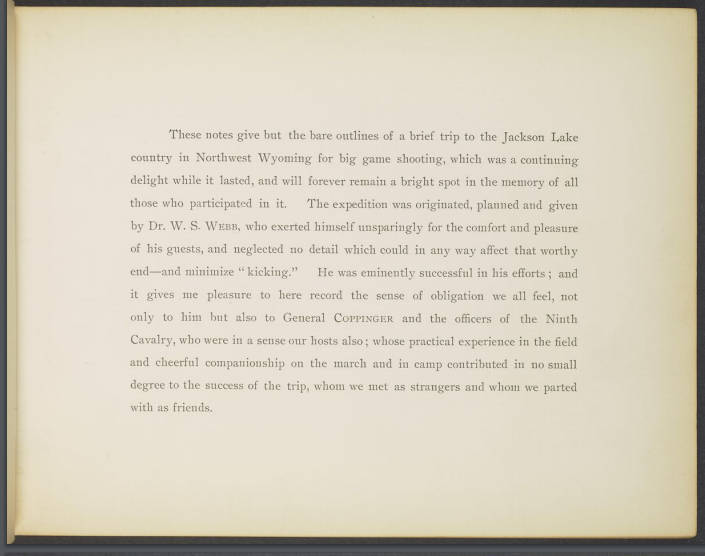
According to the itineraries, the men set off from Shelburne, Vermont (where Webb owned land) on Saturday, September 12th. Purdy wrote that the procession was elaborate; they left “by special train, consisting of private car Ellsmere, one stateroom car, one combination baggage and sleeping car and a horse car.”[4] On Monday the 14th, after traveling through Syracuse and Chicago, the group reached Missouri Valley, where the military general of the Ninth Cavalry, John J. Coppinger, and his lieutenant joined the trip. On the 15th, the party passed through Fort Robinson, where several members of the Ninth Cavalry joined them. On the 16th, the group finally arrived at Yellowstone, where they were met by the photographer Haynes, Native American guides, and the Park’s African-American rangers, who also served in the Ninth Cavalry. Dining at various hotels along the way, the group toured the main attractions of the park during their first week. By the 23rd, they set up a permanent camp, where they headed out in smaller groups to hunt elk and antelope.
The dual inclinations in the New York Journal article toward both a rugged wilderness experience and a comfortable, luxurious foray into Yellowstone are present in these books as well. Webb and his friends, described by Purdy as “tenderfeet,” were journeying to a place that had once been described as hellish and later promoted as a “Wonderland.”[5] Yet they were also traveling to a place that, by the mid-1890s, had been commodified in significant ways for consumption by the white, upper-class tourist. This often contradictory vision of wilderness is made more complicated by the roles that two-dozen Black Buffalo soldiers and two members of the Lakota Nation played in guiding the trip. Even as Yellowstone had become a more elite and racialized space through the latter half of the nineteenth century, tourists continued to rely on the services of those the park sought to exclude. Ultimately, the accounts of the 1896 trip tell many intersecting stories. I hope to touch on a few.
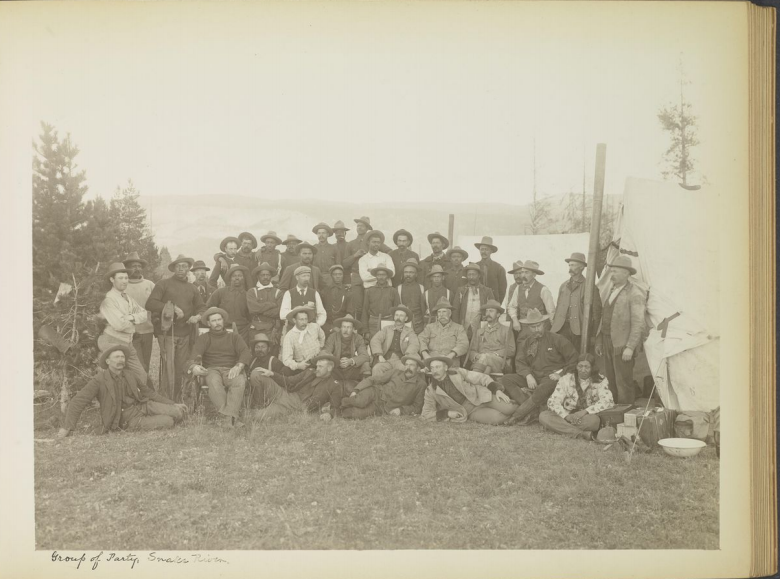
My first question was simple: who was J.H. Purdy? After scouring what felt like dozens of dead-end Ancestry.com alleyways, the answer finally came from a strange place—and time. In December of 1927, the New York Herald Tribune announced that “Mrs. William Seward Webb arrived to-day” to her home in Palm Beach, where she was a member of the elite Everglades Club. “Accompanying her,” wrote the Tribune, “were Mr. and Mrs. John Henry Purdy.”[6] With a potential name in hand, I wanted to see if the Palm Beacher from 1927 was the same Purdy from the 1890s.
Two obituaries from the New York Herald Tribune and the New York Times confirm the match by revealing that John Henry Purdy was married to Mary McKeever. Significantly, McKeever was the cousin of Robert Townsend McKeever, who took part in the first leg of the 1896 expedition and who in fact worked for William Seward Webb as his “railroad superintendent.” Further evidence in the obituaries suggests that Purdy and Webb’s friendship spanned several decades; Purdy graduated from Columbia in 1875, the same year that Webb received his medical degree from the university.
It’s fitting that the identity of J.H. Purdy was revealed through a notice about a social club. The sub-heading of the New York Times obituary revealed him as a “Member of Old New York Family Active in Many Clubs” and went on to list him as a member of “the Metropolitan, Chevy Chase and Alibi of Washington … Grolier and St. Anthony.”[7] Purdy and his wife Mary were socialites, and the two obituaries spoke to a life of luxury; the New York Times reported that at the time of his death, “[Purdy] had recently returned on the Staatendam [sic] from his annual European visit,” while the Herald Tribune noted that he resided both in Washington, D.C. and the Hotel Barclay in New York.[8] Born in September of 1853, Purdy died in 1934 at the age of 81. Purdy was a lawyer, making his nickname “The Historian” seem, like much of his writing style, tongue-in-cheek.

William Seward Webb was certainly a player in the elite New York social scene occupied by Purdy and his wife. He was the son-in-law of William Henry Vanderbilt, who had inherited his father Cornelius’ immense wealth and “railroad empire.”[9] Though he had been trained as a doctor, Webb went into the railroad business himself. Historian Maria Reynolds notes that he was responsible for the creation of the St. Lawrence & Adirondack railway, which “opened up the Adirondacks to visitors.”[10] Webb’s development of the railroad was memorialized and exalted in a 1932 book entitled Conquering the Wilderness.[11] As the title suggests, Webb’s goal appeared to not just involve making the Adirondacks more accessible to the public, but to play a part in their ownership and commodification. Reynolds writes that due to growing public concern over increasing development in the region, New York State had ceased to sell land in the Adirondacks by the mid-1880s. Yet “many wealthy individuals … had precipitated this move and purchased large tracts of land to create their own private preserves … For example, railroad magnate Dr. William Seward Webb once owned 188,000 acres of Adirondack forest … [his] railway ran through Webb’s land and he even had a rail station on the property that only his family and guests were allowed to use.”[12]
Webb’s 1896 expedition into Yellowstone had precedent. In the spring of 1889, he had travelled with his family and a group of friends from New York to Southern California. In attendance on the trip, not surprisingly, were John Henry Purdy and his wife. “I conceived the idea of organizing a private train for the party,” Webb wrote in an illustrated book he later published about the trip, “to include a baggage-car, a dining-car, and two special cars … It was to be entirely independent of time-tables, starting when we wished and running at any rate of speed we might elect.”[13] Webb’s narrative reveals an increasing upper-class fascination with America’s western landscapes, “a stretch of territory that is … the subject of never ceasing wonder.”[14]
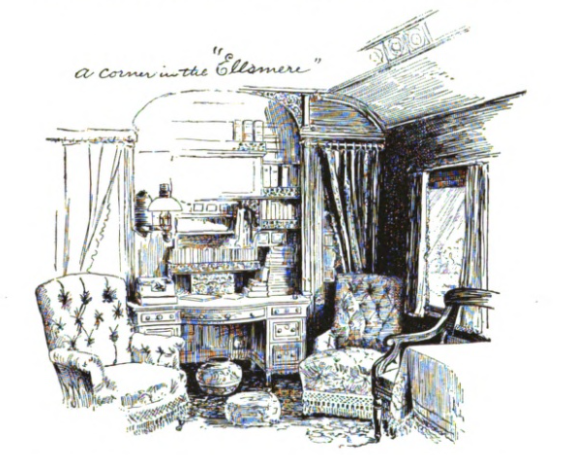
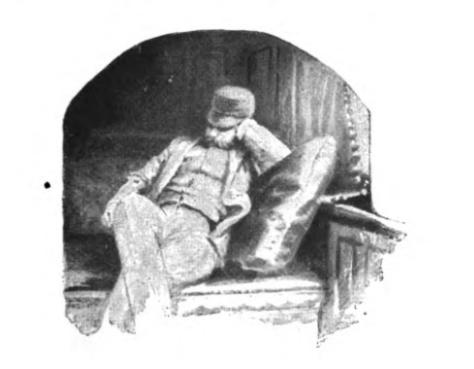
Webb’s romantic vision of life in the American West is present, too, in Purdy’s descriptions of the 1896 expedition. Purdy remarked on meeting a man called “Captain Smith,” who had apparently shed his real last name and become unfettered from the shackles of polite society. “Like most of the other citizens in this happy valley,” wrote Purdy, “he doubtlessly modestly wishes to conceal his identity … Here is no pride of birth nor vain tradition, but each hardy settler is entirely willing that his glorious past and high sounding patronymic be forgotten.”[15]
Here is no pride of birth nor vain tradition, but each hardy settler is entirely willing that his glorious past and high sounding patronymic be forgotten.
For Purdy, there was both desire and danger in shedding ties to the past in favor of the wilderness. On September 20th, while camping near the north end of Jackson Lake, Purdy recounted the story of Ray Hamilton, a New York politician who had apparently moved to Yellowstone and had later been found dead in the Snake River. He wrote, “it was here that Ray Hamilton … took up his residence when, in mid career of his ambition, he fled in disgust from the East and ‘daily contact with the things he loathed.’ The house is situated on the hillside overlooking the lake, with the grand and rugged peaks of the Teton Mountains rising abruptly from the opposite shore, and is full of souvenirs of the unhappy man who had once made it his home—Photographs, coats of arms, old prints and many trifles that must have daily reminded him of the life he had put behind him.”[16] Purdy wrote that Hamilton had been friends with many of the men on the expedition. What could it mean that a socially elite, wealthy politician—not unlike the tourists themselves—could discard his past for the frontier? Here, the “grand and rugged peaks of the Teton Mountains” seem both tantalizing and menacing in their supposed power to cut one off from civilization.
Webb and Purdy’s visions of wilderness as both terrifying and awesome—and as space to embrace a kind of rugged masculinity—were not unusual for the late 19th century. Historian William Cronon writes that the Romantic notion of the sublime was often invoked to describe America’s first national parks: “One might meet devils and run the risk of losing one’s soul in such a place, but one might also meet God."[17] Indeed, the sublime is part and parcel of Yellowstone’s creation story; the park had originally been depicted as a kind of Hell and later marketed to tourists as a “Wonderland.”[18] Cronon also notes that wilderness was also conceived as a place “of national renewal.”[19] In a place like Yellowstone, one might discard the past and perhaps fulfill the essential Turnerian prophecy of domesticating the wilderness and thus becoming a true American man.
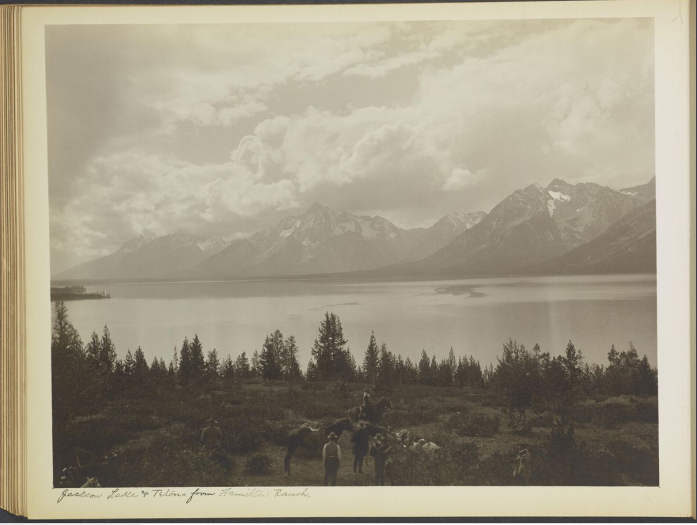
And yet, despite Webb’s descriptions of the wonders of the West, and Purdy’s musings on the humble Smiths and rugged Hamiltons of Yellowstone, what I was left with after reading the 1896 expedition was neither a sense of the sublime or the masculine “rough[ing] it” that the New York Journal had described. What comes across from Purdy’s writing is, instead, an overwhelming sense of comfort and the ease of the wealthy tourist’s experience. The men dined at hotels along their route. Those aiding the expedition, including members of the Ninth Cavalry, picked up the slack when the tourists were tired; on September 18th, for example, Purdy wrote, “we took the steamer for the lunch station at the Thumb, while the troopers led our horses round by the road. This saved us 19 miles of jogging in the saddle … More than one bruised and excoriated sportsman was grateful for the change.”[20] The biggest conflict in the story appears to occur when one member realized he’d left his special bullets at home; Purdy wrote that “the entire party was thrown into a state of consternation.”[21] The men’s poor hunting—particularly that of the Historian himself—is another frequent punchline. Purdy jokingly labeled himself and his friends “Tenderfeet.”[22] But unlike the narrator of The Virginian, the group were home in New York and Vermont within the month. Nimrods, indeed.
The group’s comfortable experience was not simply the result of Webb’s deep pockets (although those certainly played a part). In fact, a decades-long effort to commodify and market the national park had helped make Yellowstone as accessible as possible to the tourist. Langdon Smith argues that the railroad was essential in this effort: “The story of the establishment of Yellowstone cannot be told without acknowledging the behind-the-scenes influence of Northern Pacific officials.”[23] In the year before Yellowstone National Park was created, 1871, Northern Pacific investor Jay Cooke had hired the painter Thomas Moran to accompany a geologist on his survey of the park. Moran’s work, along with photographs from William Henry Jackson, “convinced Congress to protect Yellowstone.”[24] By 1882, ten years after the park’s establishment, the Northern Pacific had been granted “exclusive rights to hotels, stages and telegraph service within the park … the right to cut timber for construction and fuel, and to farm some areas of the park.”[25]
In the accounts of the 1896 expedition, the rapid development of Yellowstone is most obviously on display in the photographs of F.J. Haynes. Haynes had worked for the Northern Pacific railroad and by the late 1880s, had been hired as the park’s official photographer. In these books, Haynes’ photographs sprawl across the entire page, giving the viewer a sense of immersion in Yellowstone. Some images, like Yellowstone’s Grand Canyon, or an image of Jackson Lake, also evoke earlier renderings of the sublime. Yet many of these images are marked indelibly by the work of the Northern Pacific. The first image in the book is a train pulling into Cinnabar, Montana, the station that the railroad had established in 1883. Paths through jagged rock formations and chasms are smooth and paved. In one image, a rock formation called the Minerva Terrace is foregrounded. But in the background, the National Hotel looms. According to Smith, the National had “consumed 1.6 million board feet of park timber.”[26]
Historian Chris Magoc argues that the presence of the tourist was inextricably linked to Haynes’ body of work. “Although the sublime remained the key to Yellowstone’s symbolic hold on the American imagination,” Magoc explains, “Haynes’s charge was to prettify and make inviting a rather uninviting landscape. William Henry Jackson’s photographic work … had reinforced the awesome geomorphic affect that made the region worthy of park status. A decade later, however, Haynes’s commercial patron wanted the region clearly presented as the domain of the tourist.”[27]
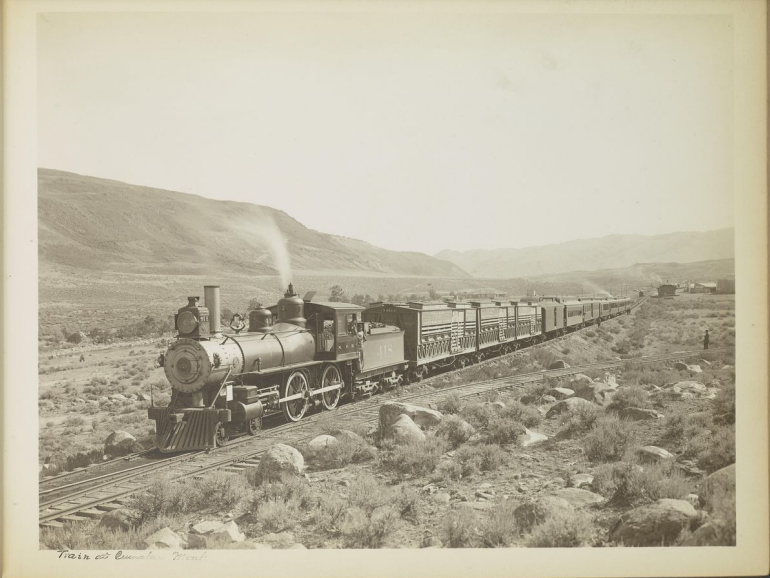

The most striking images in the 1896 books are not just that of a landscape marked by tourism, but one seemingly dominated by it. In one image entitled “Taxidermists,” the men appear to be removing the heads of elk from their antlers. In the next image, three elk heads have been strapped to men’s horses. Sprouting from the middle of the horses’ backs, the elk heads make the animal look like some kind of two-headed beast, a strange hybrid of domesticity and wilderness. These images seem to want to tell a story of the hunters’ superiority over the landscape, a bombastic display of masculinity. Yet at the same time, and in light of the Northern Pacific’s efforts to make Yellowstone as accessible as possible, this masculinity seems like a kind of cosplay.
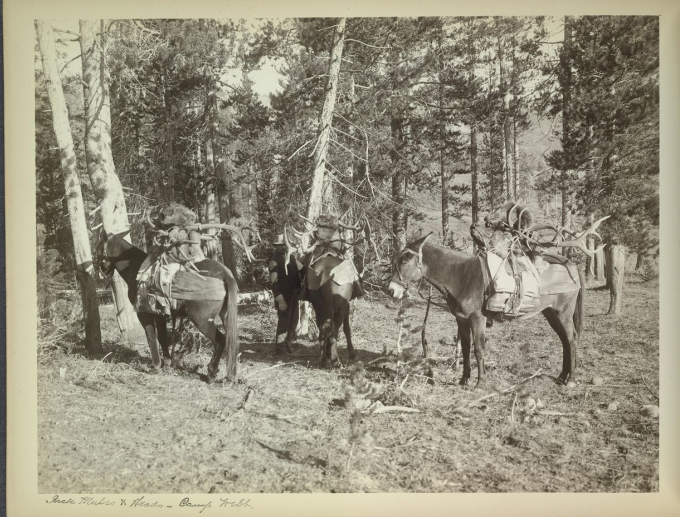
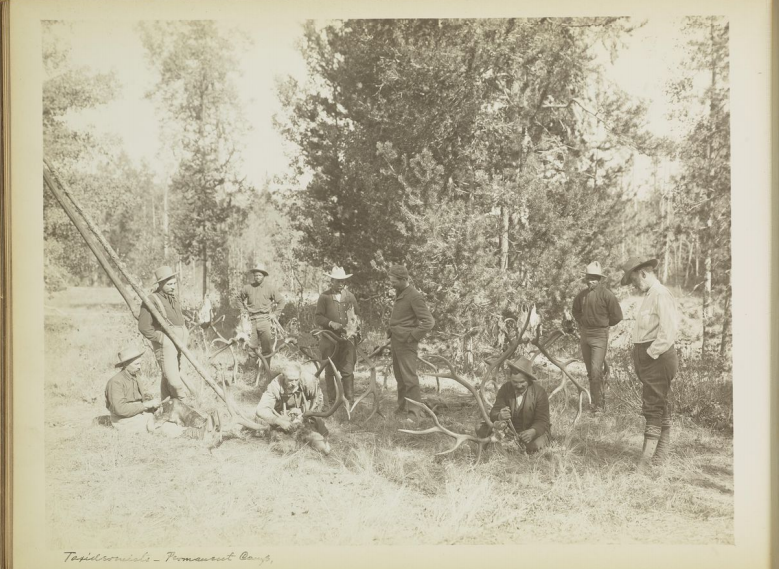
It’s important to note that the men’s hunting, and their expedition at large, would not have been possible without the two members of the Lakota Nation and the two-dozen African-American members of the Ninth Cavalry accompanying them.
Baptiste Garnier, or “Little Bat,” joined the expedition as a “Government Scout and Interpreter and Mighty Hunter.”[28] Little Bat was born in 1854 to a French-Canadian father and Lakota mother, who had both died when he was child. As an adult, Little Bat worked as a scout and interpreter at Fort Laramie and Fort Robinson.[29]
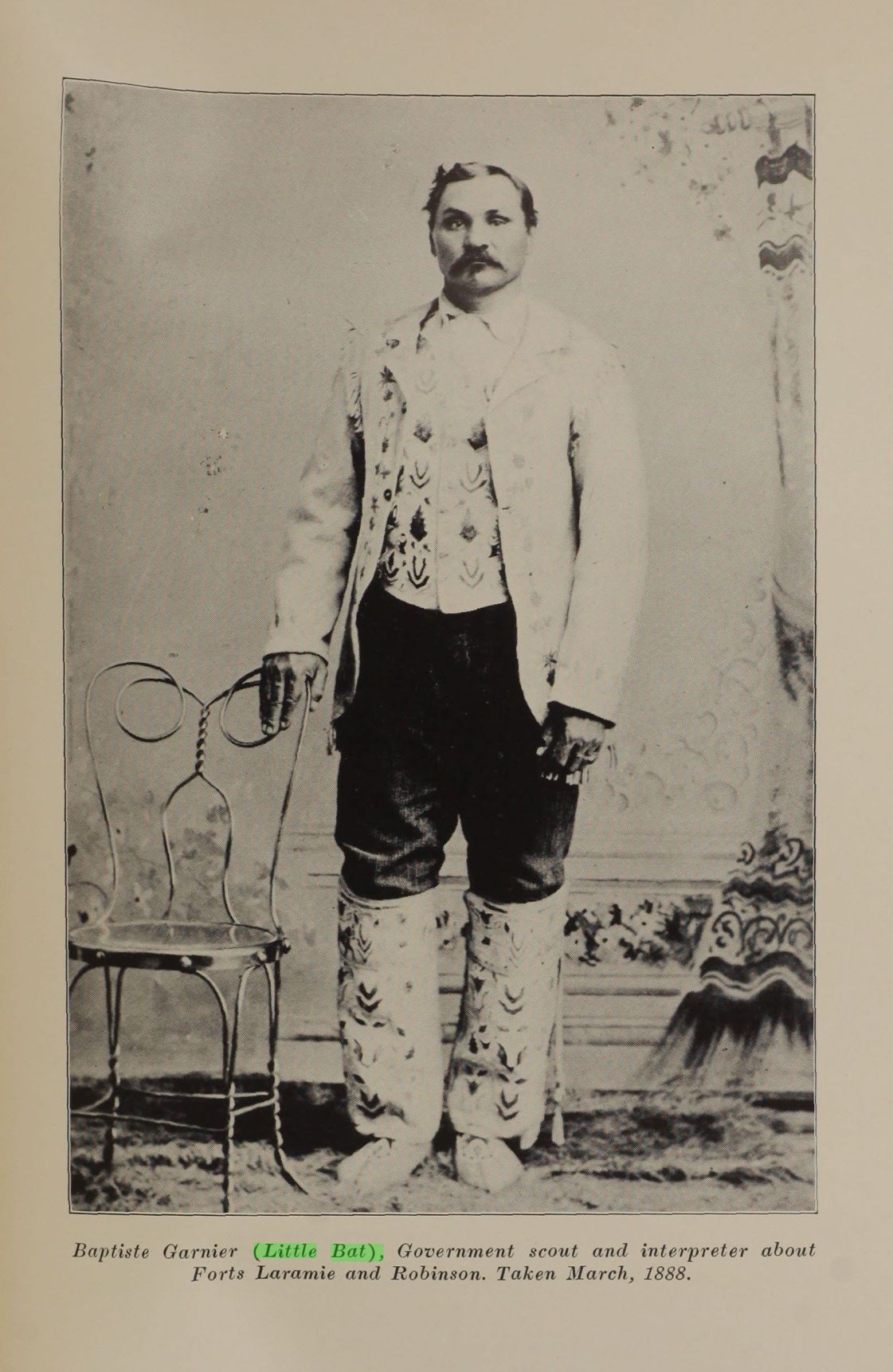
In Fifty Years on the Old Frontier (1923), fellow Fort Robinson scout James H. Cook recalled his close friend Little Bat’s hunting skill and even mentioned trips similar to the 1896 expedition. “He was considered … one of the best big-game hunters in the Rocky Mountains,” wrote Cook. “When such well-known civilians as William K. Vanderbilt and Dr. Seward Webb wanted to hunt big game in the Rockies, they usually secured the services of Little Bat for their trips.”[30]
Yet despite the fact that the U.S. government and wealthy tourists alike relied on his acumen, Garnier was subject to intense racism even after his death in 1900. According to Cook, Little Bat was shot by a drunken bartender, who was entirely acquitted of charges. “To many persons about Crawford,” wrote Cook, “Little Bat was seemingly ‘nothing but an Indian.’”[31] Cook noted that his historical legacy was similarly diminished at his gravesite in Fort Robinson: “This simple little marker gives his name, the date of his death, and underneath is chiseled the one word, ‘Employee.’”[32] The disturbingly reductive commemoration speaks to the ways that Native Americans identities have been diminished in national public memory and in the archives themselves.
Arthur Short Bull, a watercolor artist based out of Colorado, knows something about this kind of historical erasure. His great-grandfather was Grant Short Bull, a member of the Oglala Sioux who served as a guide on the 1896 expedition. For years, his relative’s identity had been conflated in the historical record with Arnold Short Bull, a Brulé who had similarly been born around 1851. On his website, Arthur writes that the conflation “obliterat[ed] the true historical identities of both men.”[33]
Arthur explained over the phone that growing up, he hadn’t been able to learn much about Grant; Grant and his son had died in a car crash on the Pine Ridge reservation in 1935. The one story Arthur did hear was a funny one: “We used to laugh at the fact that I’m now six feet, six inches tall. And he was five feet four. Basically, we were wondering what happened.”[34]
Arthur recalled that in 1990, he decided to start a paper trail and find out as much as he could about Grant. His research led him to the National Archives in Kansas City. There he discovered ledgers drawn by the artist Amos Bad Heart Bull that depicted his great-grandfather. Through the ledgers, Arthur learned that Grant was a scout at Fort Robinson and served as a mediator between the army and the Lakota. Later, he was working as an artist in residence at the Agate Fossil Beds in Nebraska. When he happened to visit James H. Cook’s ranch, he discovered letters from his great-grandfather to Cook. “Through my life in the arts,” Arthur explained, “I’ve been led to people, places where somehow, it’s always connected with my great-grandfather.”[35]
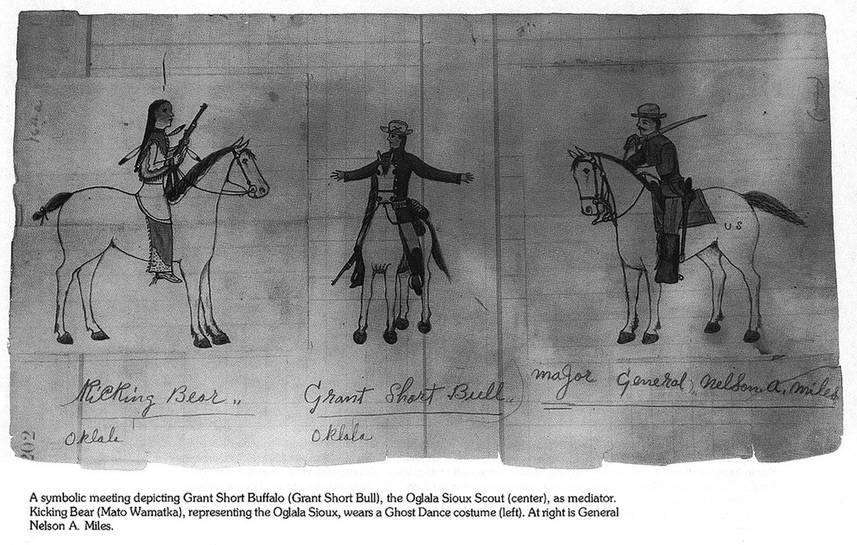

Although he hadn’t known of the 1896 expedition, Arthur noted that his ancestor’s role made sense, given his military position and knowledge of Wyoming’s land. As for his own beliefs about Yellowstone, Arthur explained, “The only positive thing I can say about national parks is that at least they do keep [them] pristine in some cases. I fully enjoy the animals. I enjoy that, because that shows me that at one time, this country was a beautiful place to be … But at the same time, my entire life I’ve always had problems with people claiming territory that does not belong to them.”[36]
Arthur’s comment speaks to a crucial irony about the Purdy journals. Despite the continued reliance of Yellowstone’s tourism on the services and expertise of Native American guides, the park had for years engaged in a campaign to exclude Indigenous populations from the park. Part of that effort was promoting the idea that Native Americans were frightened of Yellowstone and had in fact neither hunted nor lived in the park grounds. Chris Magoc explains that “the fiction of cowering Indians conveniently complimented [Yellowstone Superintendent] Norris’s 1880 regulation that prohibited Native Americans from entering the Park.”[37] In fact, a band of Arapahoes had historically lived in the Park, while members of the Shoshone, Bannock, and Crow tribes engaged in seasonal hunting in the region. Throughout the ’80s and ’90s, the U.S. government and white settlers were increasingly hostile to Indigenous hunters. In fact, the year before Purdy’s trip, white settlers had killed several Bannock elk hunters who “never fired a shot.”[38]
Another tension in the Purdy account is the role of the twenty-four African-American Buffalo soldiers on the trip. The U.S. military had controlled Yellowstone since 1886, with the Buffalo soldiers acting as some of the nation’s first park rangers. Purdy unfortunately does not name any of the soldiers, making it difficult to track down their individual stories. It’s interesting to consider that the Buffalo soldiers may have had contradictory positions in some ways. As part of the U.S. military, Buffalo soldiers “forced Native Americans off their land in often violent and deadly ways.”[39] At the same time, African-Americans were themselves excluded and discouraged from wilderness spaces like Yellowstone. Purdy’s language is revealing of the group of white tourist’s racist ideologies. Although he describes the Buffalo soldiers as “a goodly number of colored warriors,” he also at one point informs his audience, in almost a joking manner, that Dr. Webb has named one of their horses a racial slur.[40]
Haynes’ photograph of the entire group speaks to a kind of camaraderie between the group, with Black, Native American, and white men standing and sitting side by side. But the last photograph in the collection has a lot to say, too. A man—perhaps the “Historian” Purdy—lays down, sleeping in his tent on what looks like a comfortable pillow, his boots laced, and his leather luggage beside him. The wilderness is somewhere outside the confines of the cozy tent. Maybe Purdy arranged that photo last for a comedic purpose—to show an audience back home, perhaps, that the group wasn’t truly “rough[ing] it.” That impression sticks with the viewer. In 1896, Yellowstone was not necessarily a place of rugged, hellish wilderness or sublime wonder. Nor was it a space that all Americans could access equally. Instead it was, for the upper-class white tourist, a place of leisure.
Toward the end of our conversation, Arthur Short Bull reflected on the often trivial nature of the tourists’ concerns, especially in comparison to the men on the expedition facing increasing exclusion from wilderness spaces.
“I got a kick out of the fact that the one gentleman was so angry that his special bullets didn’t come through,” Arthur laughed. “He’d ordered them just for the trip.”[41]
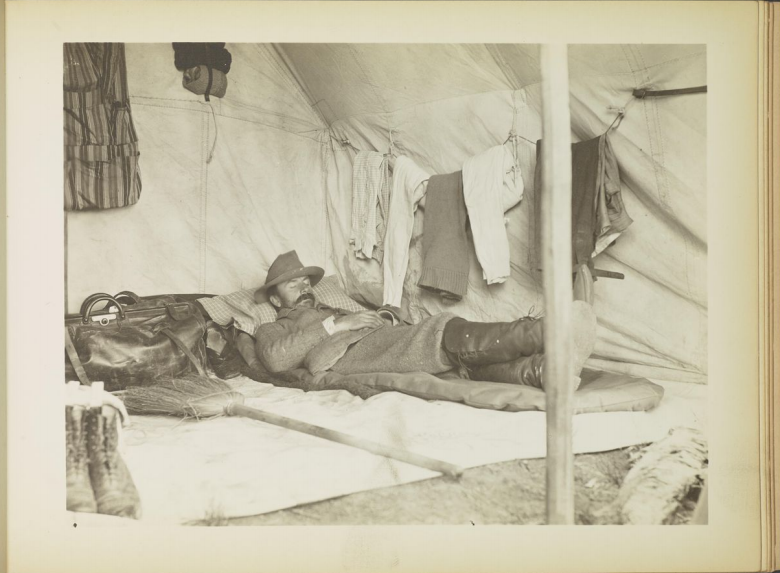
[1] “Will Hunt Big Game in the Wild West.” New York Journal, 4 Sept. 1896. Library of Congress, https://tile.loc.gov/storage-services/service/sgp/sgpbatches/batchdlcarchibald_ver01/data/sn84024350/print2435/1896090401/0027.pdf.
[2] “Notes and Photographs of a Trip to the Jackson Lake Country in Northwest Wyoming for Big Game Shooting.” Sotheby’s, https://www.sothebys.com/en/buy/auction/2018/fine-books-manuscripts-online/b2ec1b69-adca-4c60-83a6-2160ac27df38; “Notes and Photographs of a Trip to the Jackson Lake Country in Northwest Wyoming for Big Game Shooting.” AbeBooks, https://www.abebooks.com/NOTES-PHOTOGRAPHS-TRIP-JACKSON-LAKE-COUNTRY/30686685305/bd.
[3]J.H. Purdy. Bare Outlines of a Brief Trip to the Jackson Lake Country in Northwest Wyoming. University of Vermont, http://primo.uvm.edu/permalink/f/1mpllsg/UVM_VOYAGER1297402.
[4] J.H. Purdy. Bare Outlines of a Brief Trip to the Jackson Lake Country in Northwest Wyoming. Princeton University Library, https://catalog.princeton.edu/catalog/2639508, 16.
[5] Purdy, 17; Chris Magoc. Yellowstone: The Creation and Selling of an American Landscape, 1870 - 1903. University of New Mexico Press, 1999. Print. 22.
[6] “Mrs. W. Seward Webb Arrives at Palm Beach: Friends and Relatives Accompany Her in Private Car.” New York Herald Tribune, 9 Dec. 1927. Retrieved from ProQuest.
[7] “John Henry Purdy: Member of Old New York Family Active in Many Clubs.” New York Times, 28 Sept. 1934. Retrieved from ProQuest.
[8] “John Henry Purdy: Retired Lawyer, Great-Grandson of Samuel Riker, Dies.” New York Herald Tribune, 29 Sept. 1934. Retrieved from ProQuest.
[9] Natalie Robehmed. “The Vanderbilts: How American Royalty Lost Their Crown Jewels.” 14 Jul. 2014, Forbes, https://www.forbes.com/sites/natalierobehmed/2014/07/14/the-vanderbilts-how-american-royalty-lost-their-crown-jewels/?sh=6be1c99b353b.
[10] Maria Reynolds. “Doing History in the Adirondacks: Interpreting the Park, the People, and the Landscape.” Loyola University Chicago eCommons, 2011, https://ecommons.luc.edu/cgi/viewcontent.cgi?article=1075&context=luc_diss, 77.
[11] Charles Howard Burnett. Conquering the Wilderness: The Building of the Adirondack and St. Lawrence Railroad by William Seward Webb, 1891-92. Norwood, MA: 1932. Retrieved from https://onlinebooks.library.upenn.edu/webbin/book/lookupid?key=olbp55132.
[12] Reynolds, 46-7.
[13] William Seward Webb. California and Alaska, and Over the Canadian Pacific Railway. New York and London: G.P. Putnam’s Sons, 1891. Retrieved from Hathitrust, https://babel.hathitrust.org/cgi/pt?id=uc1.b3625278&view=1up&seq=11, vi.
[14] Webb, v.
[15] Purdy, 20-1.
[16] Purdy, 20.
[17] William Cronon. “The Trouble with Wilderness.” Uncommon Ground: Rethinking the Human Place in Nature. New York: W.W. Norton & Co, 1996. Print. 73.
[18] Chris Magoc. Yellowstone: The Creation and Selling of an American Landscape, 1870 - 1903. University of New Mexico Press, 1999. Print. 22.
[19] Cronon, 76.
[20] Purdy, 19.
[21] Purdy, 16.
[22] Purdy, 17.
[23] Langdon Smith. “The Contested Landscape of Early Yellowstone,” Journal of Cultural Geography, 2004. Retrieved from Taylor & Francis Online, https://www.tandfonline.com/doi/abs/10.1080/08873630409478245, 6.
[24] Smith, 7.
[25] Smith, 13.
[26] Ibid.
[27] Magoc, 44-5.
[28] Purdy, 18.
[29] “Baptiste ‘Little Bat’ Garnier.” Metis Museum, http://www.metismuseum.ca/media/db/11904.
[30] James H. Cook. Fifty Years on the Old Frontier. Retrieved from Gale Primary Sources, https://go-gale-com.ezproxy.princeton.edu/ps/i.do?id=GALE%7CGRPTNM974799337&v=2.1&u=prin77918&it=r&p=CPPC&sw=w, 195.
[31] Cook, 196-7.
[32] Cook, 197.
[33] Arthur Short Bull. Personal Interview. 8 May, 2021.
[34] Ibid.
[35] Ibid.
[36] Ibid.
[37] Magoc, 4-5.
[38] John Clayton. “When White People Stopped Indigenous Elk Hunts in Jackson Hole.” Mountain Journal, https://mountainjournal.org/jackson-hole-was-flashpoint-for-battle-over-indigenous-hunting-rights.
[39] “Why Buffalo Soldiers Served Among the Nation’s First Park Rangers,” https://www.history.com/news/buffalo-soldiers-national-parks-rangers.
[40] Purdy, 18-19.
[41] Short Bull.